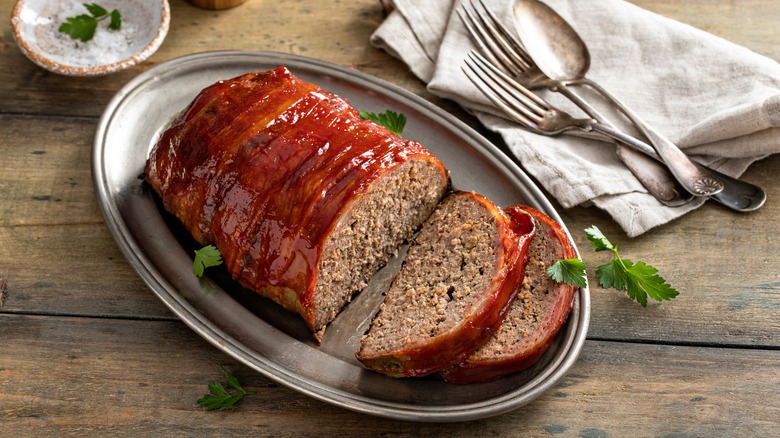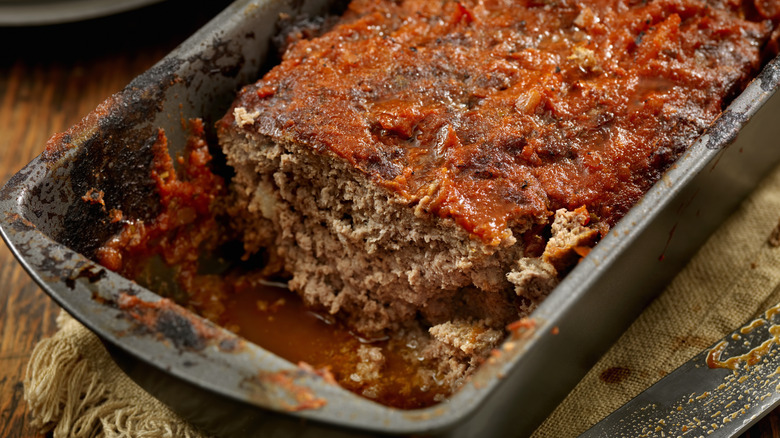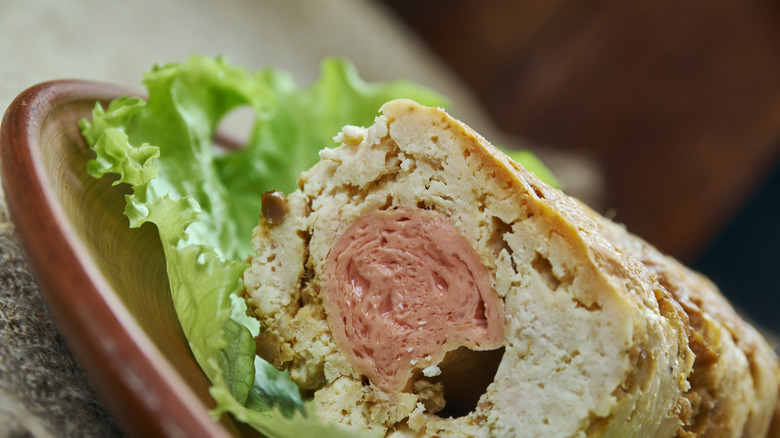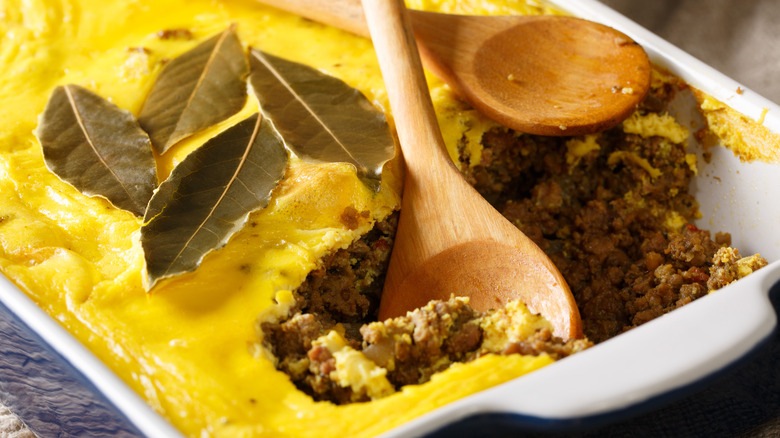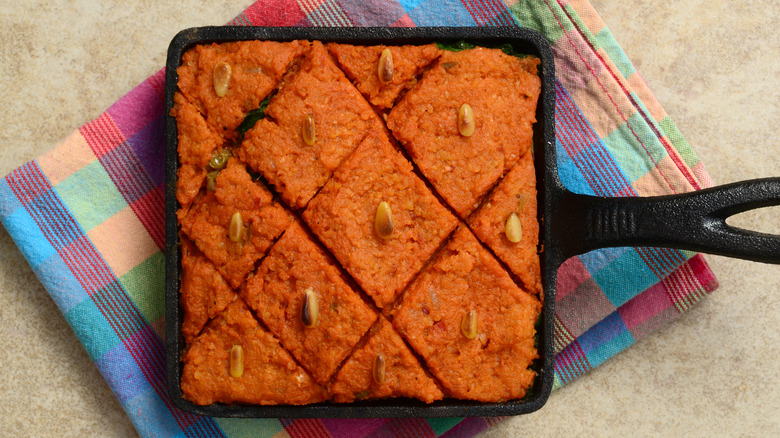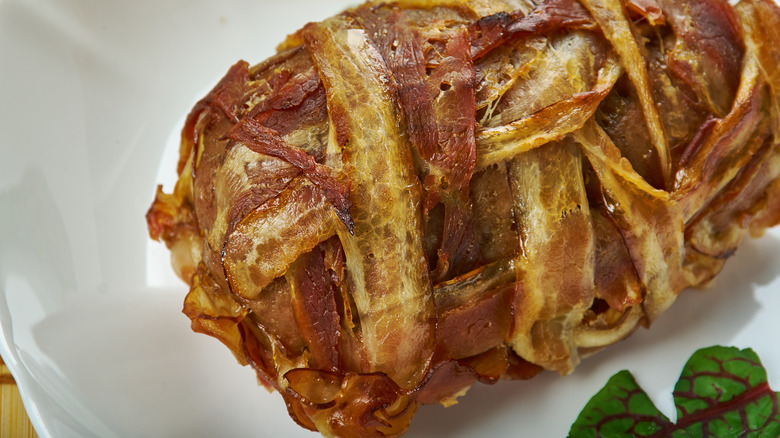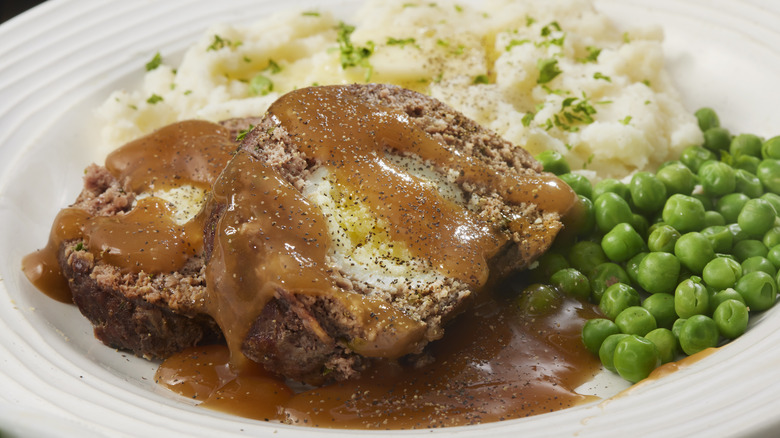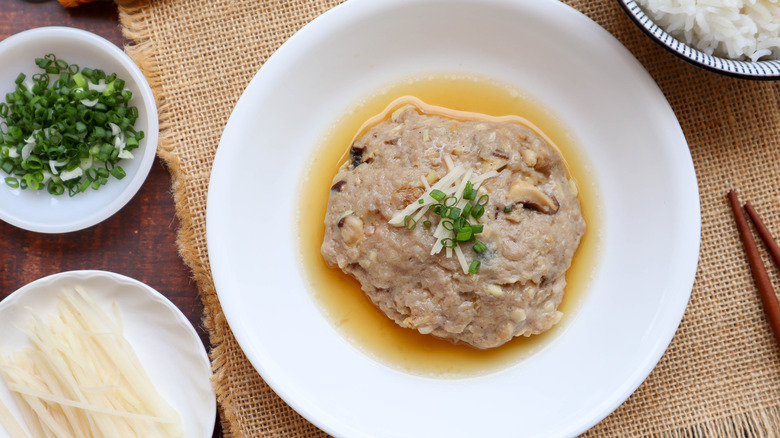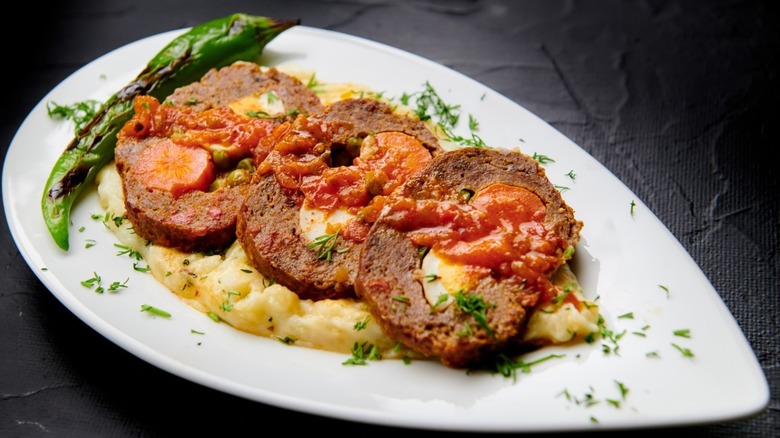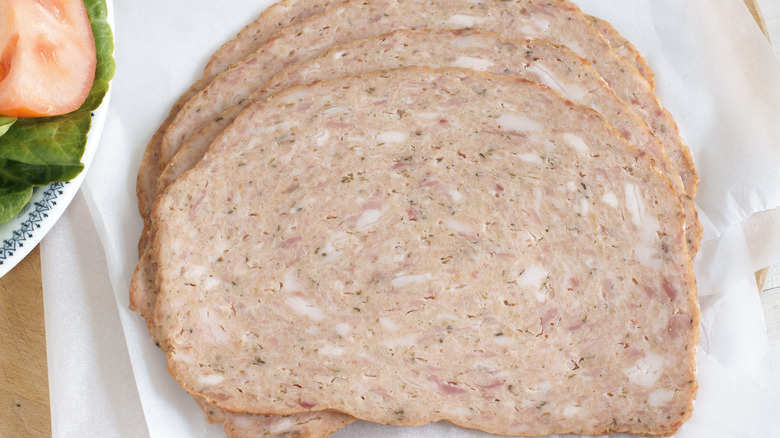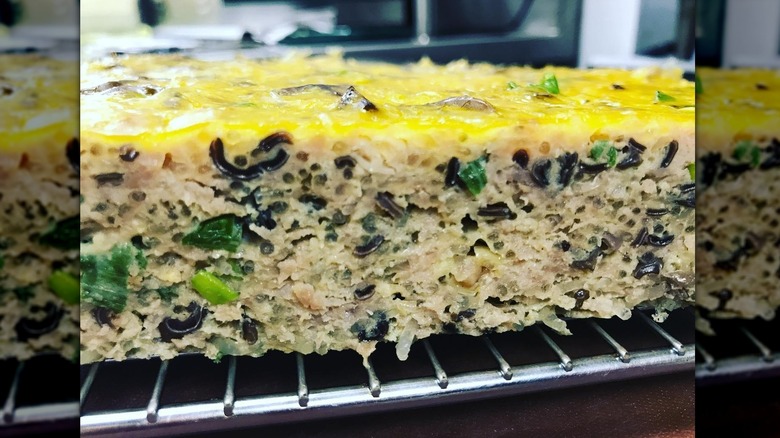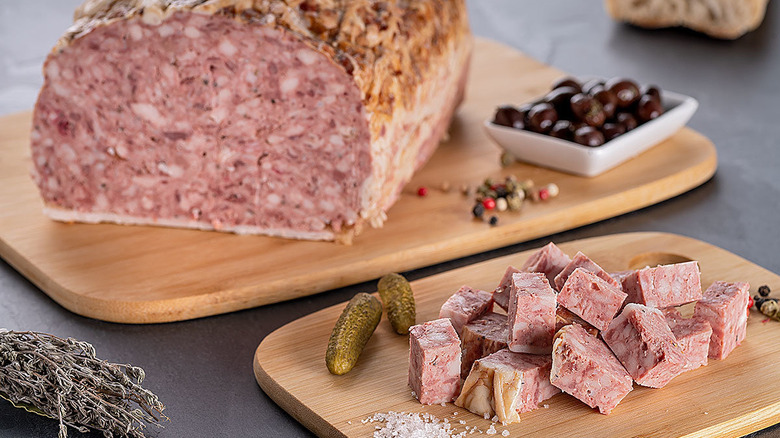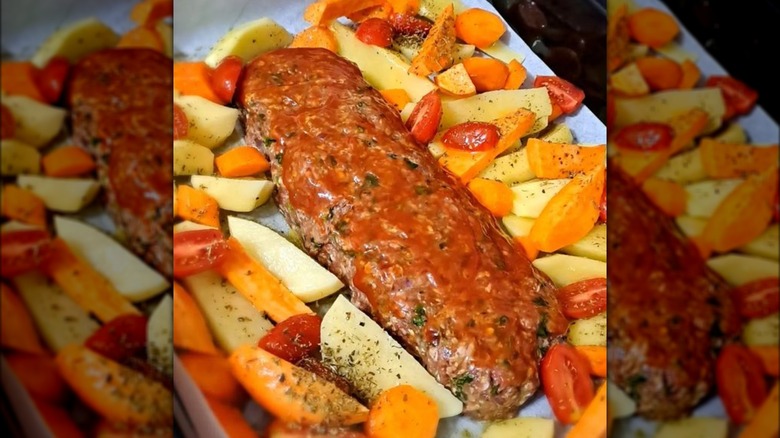12 Meatloaf Variations Found Around The World
Meatloaf is far more ancient than you might think. Long before it became a symbol of American home cooking during the great depression, the lowly meatloaf graced the ancient tables of Rome. The first mention of minced meat patty made with bread and wine in the Apucius cookbook traces back to the 4th century AD. However, the meatloaf we know today finally took shape in the late 1800s thanks to the appearance of the meat grinder.
Stripped to its bare elements, the meatloaf is an excellent example of culinary ingenuity. The basic combination of ground meats, like beef or pork, bound with tomato paste, breadcrumbs, onions, and eggs, forms a deliciously rich loaf — a wonderful budget-friendly meal you can whip up for any occasion.
While it may not sound like the most exciting dish out there, the meatloaf has traveled the world, embraced and reimagined by different cultures. Some variations might leave you surprised, and others will undoubtedly inspire you. From the French pâté de campagne, a rustic terrine of pork and liver, to the fragrant Vietnamese steamed pork and shrimp cake, your meatloaf never has to be boring again.
1. Polpettone (Italian meatloaf)
Polpettone, simply put, means "large meatball." Like most meatloaves, the Italian version started as a humble, practical answer to leftovers in the kitchen, eventually becoming a cherished staple of family gatherings. In Naples, Polpettone is a traditional Sunday meal gracing the table, often served with a slow-cooked tomato sauce but can also feature mashed potatoes or summer green beans in other parts of Italy.
Polpettone's uniqueness comes from its distinctive Italian ingredients, like the savory fat of prosciutto complementing the beef, provolone, or Parmigiano cheese richness, and hard-boiled eggs, all seasoned with garlic, butter, and parsley. The real secret, however, comes from incorporating slices of crusty Italian bread soaked in milk — a technique guaranteeing a tender and juicy meatloaf that rarely disappoints.
Fresh from the oven, Polpettone boasts a beautiful golden-brown crust, perfect juiciness, and the reassuring fragrance of Italian herbs. It's best enjoyed at room temperature, and you can substitute the provolone filling with mozzarella, caciocavallo, or smoked scamorza.
2. Embutido (Filipino meatloaf)
Embutido is a beloved Filipino staple that offers a distinctive, slightly sweeter twist on traditional meatloaf. It's a dish that holds a special place in the hearts of many Filipinos, enjoyed with the same affinity as a casual lunch or a festive meal for special occasions. While pork is the typical meat for this meatloaf, versions made with chicken or turkey are also commonly served.
Most embutido recipes begin with ground pork mixed with onions, red bell peppers, carrots, sweet relish, raisins, and cheese. Breadcrumbs or milk-soaked bread can be added to bind the ingredients together. This mix is then shaped into logs, wrapped in foil, and steamed. Some might place a hard-boiled egg in the center, giving each slice a pop of color, but this is purely optional.
When it's time to eat, embutido can be enjoyed either hot or cold, usually accompanied by a serving of rice. However, there's something deeply satisfying about eating it in a sandwich for breakfast; layered with mayonnaise, it becomes the ultimate lunch favorite. To make things even more naughty, try the pan-fried embutido with either banana ketchup or sweet chili sauce.
3. Bobotie (South African curry meatloaf)
Bobotie is a South African dish that leans more towards a meat pie than a meatloaf, similar to the Greek moussaka. At the core of it is a hearty mix of minced lamb and beef, sweetened with dried fruit like apricots or raisins and a generous dollop of chutney. Curry spice brings warmth and complexity, while a lavish layer of egg custard rounds off the dish with a creamy, decadent touch.
Bobotie's roots trace back to the Cape Malay community on the western cape of South Africa. In the 17th century, enslaved people were brought from southeast Asia to work for the Dutch East India Company, infusing the local cuisine with their unique spices and cooking techniques.
To prepare the bobotie, all ingredients are simmered in a pan and mixed with bread soaked in milk, giving the meatloaf its moist, tender texture. The mixture is then pressed into a baking dish or, better, cast iron skillet and baked for about 45 minutes. The eggs whipped with milk create a nice golden crust to finish it off. Once ready, bobotie is usually served with warm rice or fresh salad.
4. Kibbeh (Lebanese meatloaf)
Kibbeh is a ground meat delicacy widely enjoyed in Lebanon and other parts of the Middle East. The name comes from the Egyptian Arabic word "kubba," meaning "ball" or "lump." Kibbeh mixture can be cooked a few different ways, but the baked version called "kibbeh bil seniyeh" is the closest cousin to the traditional meatloaf.
Making kibbeh is an art that requires skill and patience. Traditionally, lamb or goat meat and bulgur are blended into a paste with a stone mortar. Some still prefer this method over a food processor, giving the kibbeh a better texture and flavor. What sets it apart is its intricate layering: The base and the top seamlessly blend meat, regional spices, and bulgur, while a sumptuous filling combines pine nuts with butter, meat, and lemon in the middle.
Kibbeh comes to life when served with a variety of sides — from Lebanese cabbage salad with garlic to creamed lentils and Syrian mint sauce. Fresh vegetables like radishes or cucumbers also add a nice crunch to the dish.
5. Forloren hare (Danish meatloaf)
Forloren hare, or "mock hare," is a classic Danish meatloaf beloved throughout Scandinavia. This savory dish, cloaked in thin bacon strips and served with a simple yet delicious gravy, is the ultimate comfort meal. The meatloaf is typically made with ground pork and beef and soft breadcrumbs soaked in milk, butter, fresh parsley, dill, and a pinch of nutmeg. Garlic and onion add an aromatic heartiness that binds the whole dish together.
The ingredients are carefully mixed together with eggs until they are just combined. The mixture is then shaped into a loaf on baking paper and topped with bacon strips tucked under the loaf's edges. The bacon crisps to a golden brown as the meatloaf bakes, adding a visually delightful crunch. Forloren hare is traditionally served with brown gravy, currant jelly, baby potatoes, and a side of steamed greens — a super easy dish to make, perfect for Sunday lunch.
6. Hackbraten (German meatloaf)
If you ever visit a German home for dinner, chances are you will be served hackbraten ("minced roast" in German), a hearty meatloaf that looks like a sleeping bunny. This dish earned the nickname "fake rabbit" after World War II when rabbits were hard to come by. It has since become a staple of German cuisine, especially for family gatherings.
High-quality ground meat is the foundation of a good hackbraten. A blend of pork and beef is traditional, but you can also use lamb or venison. The meat is then mixed with a variety of spices, including mustard, paprika, and gherkins, as well as binding agents like bread and eggs. The mixture is shaped into a loaf and baked in the oven. A hard-boiled egg is often tucked inside the loaf, a particularly beloved feature during the German Easter season.
Hackbraten is best enjoyed with traditional German sides such as parsley potatoes, red cabbage with apple, or potato dumplings. Drizzling authentic German sauce over it is a must; rahm sauce, a velvety cream sauce, or jager sauce, a rich mushroom sauce, are both a good fit for the occasion.
7. Zheng rou bing (Chinese steamed pork cake)
One of the most beloved dishes in Cantonese cuisine is a steamed pork patty, a moist and tender meatloaf that pairs minced pork with the sweet and salty crunch of preserved turnips. Unlike most baked meatloaves, this Chinese delicacy is steamed, which preserves all the natural juices and flavors of the meat inside.
The key ingredients of this classic dish are pork shoulder and preserved turnips – a distinctive flavor of many Cantonese dishes. You can find them in most Asian grocery stores; otherwise, marinated daikon works just as fine.
The pork shoulder is minced and marinated in a simple blend of light soy sauce, sesame oil, garlic, sugar, and cornstarch. This helps to enhance the flavor and texture of the pork and bind the patty together. The patty should be left to marinate for at least a few hours, longer if possible. Once steamed, it can be topped with an egg yolk and some spring onions. It is best served with a bowl of steamed rice and a side of greens.
8. Dalyan kofte (Turkish meatloaf)
In Turkey, there are various kofte meatballs, each with a unique shape and size. One of the lesser known is the dalyan kofte, a full-size meatloaf with a surprise inside: a row of hard-boiled eggs nestled among a colorful mix of vegetables. The whole thing is smothered in a rich tangy tomato sauce, adding to its irresistible appearance.
Dalyan kofte is usually prepared with medium-fat ground beef, finely chopped onion, breadcrumbs, egg yolk, and a hint of seasoning like cumin, cracked pepper, and salt. To begin with, the meat mixture is spread evenly onto a greased paper-lined baking tray. It is then carefully folded over the eggs and vegetables to form a log and brushed with egg whites before placing it into a piping hot oven. Once the meatloaf is perfectly golden, it's covered in sauce and left to continue roasting in its juices. Dalyan kofte pairs beautifully with a side of mashed potatoes or plain pilaf.
9. Haslet (English meatloaf)
Hailing from Lincolnshire, the heartland of England's pig farming, haslet is an old recipe still held dear among the British today, at least in the North. Haslet was synonymous with offal or pluck, hinting at its primary ingredients: the pig's heart, liver, and lungs. Over time, the name has come to represent a unique dish that may resemble a rustic terrine more closely than a traditional meatloaf.
If offal isn't your favorite idea of a meat delicacy, a simple version of haslet can be made with minced pork alone. The traditional way, however, would be to combine the pig's heart, liver, and shoulder and season it with pepper, nutmeg, and sage — a quintessential British spice blend for sausages. This version, slightly richer in fat, requires less bread and milk, while the offal gives the dish its signature flavor. Haslet is typically served cold, either in sandwiches or with pickles and salad. Occasionally, it may be fried in a pan to give it a crispy texture and served as a part of a hearty breakfast.
10. Cha trung hap (Vietnamese steamed egg meatloaf)
Vietnamese steamed egg meatloaf, also known as cha trung hap, is a dish that completely transforms the traditional concept of meatloaf. It is anything but dull — from the beautiful golden egg yolk topping to the wood ear mushrooms and mung bean noodles, giving the dish its distinctive texture.
A mix of minced shrimp and pork is the most common choice of protein for the cha trung hap, but you could also try playing with other meats or tofu. Clear cellophane noodles, wood ear mushrooms, and fragrant herbs like green onions and cilantro are absolutely essential, with eggs forming the core of this dish and a splash of fish sauce adding more depth.
Apart from pre-soaking noodles and mushrooms, you only need a half-hour to yield a juicy, flavorful meatloaf. To prepare cha trung gap, you would start by setting up a steamer. While it heats up, combine all the ingredients except for the egg yolks. After the meatloaf is steamed, brush the top with the egg yolks and let the heat work its magic. Vietnamese love serving cha trung gap with com tam ("broken" rice) and some crunchy pickles.
11. Pâté de campagne (French meatloaf)
Pâté de campagne, or country pâté, is the French answer to the American meatloaf. It is a rustic delight from the heart of the countryside, a guaranteed showstopper for any gathering. Its rich yet pleasant texture makes it a must-have for any charcuterie.
Pâté de campagne is a baked loaf of ground meats, typically pork and liver, imbued with a blend of spices and a splash of Cognac. The liver's rich sweetness is indispensable to the paté's character — pork liver works best. You can use ground ginger, nutmeg, and cloves to add flavor to the dish while adding some coarsely ground black pepper will give it a nice kick. The mix is held together with an egg and enriched with double cream and sautéed shallots.
An essential technique for achieving a moist and light texture in pâté is to line the mixture with either caul fat (which comes from the digestive membrane of sheep and cows) or bacon strips. Typically, pâté de campagne is not served warm; it is pressed down with weights and refrigerated overnight. To enjoy it, slice it on crusty French bread with a glass of red wine.
12. Rolo kima (Greek meatloaf)
Rolo kima, a Greek variation of the classic meatloaf, used to be a crowd-pleaser at family gatherings due to its sheer comfort and simplicity. While it may have lost some of its popularity in Greece, you can still indulge in this deeply satisfying dish — perfect for expanding your meatloaf repertoire.
Traditional recipes for rolo kima call for a combination of minced beef and pork mixed with breadcrumbs, shredded carrots, tomato, aged mizithra cheese (or a blend of grated Parmesan and Romano cheese), garlic, and unmistakably sharp Greek oregano. The perfect finishing touch for this is a pinch of nutmeg and all-spice berries.
To assemble the meatloaf, the meat mixture is carefully wrapped around boiled eggs, although that's totally optional. Once ready for roasting, the loaf is carefully placed on a bed of tender potatoes and carrots and covered in a delicious broth. So when you finally dig in, the generous helping of juices from the pan makes this dish truly unforgettable.
